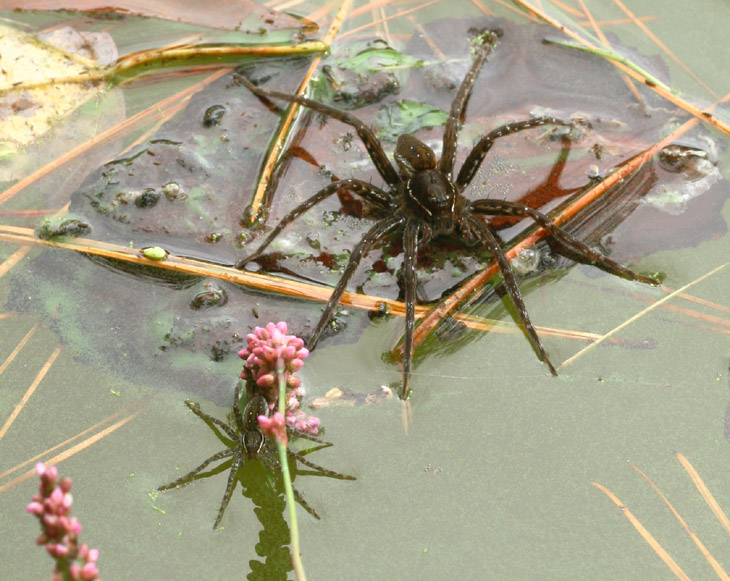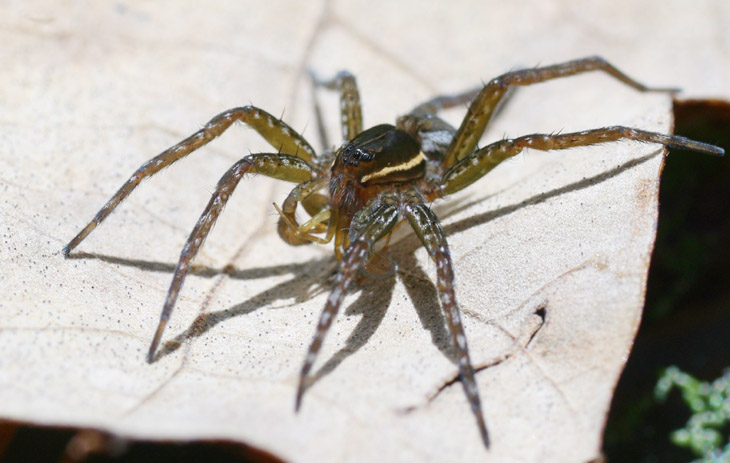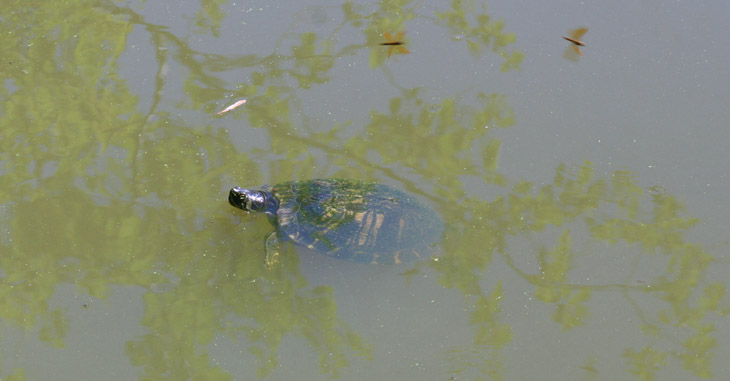I’m not going to finish that header, because no matter what, it’s going to be taken the wrong way…
If you’ve been checking out links on that blogroll over on the sidebar, you may be aware that Ed Yong at Not Exactly Rocket Science has a semi-regular Saturday post called, “I’ve Got Your Missing Links Right Here,” that often has links to some interesting science articles. This week’s, however, presented a feature from The Atlantic that just completely misses the boat.
The article is “The Sexism of American Kitchen Design,” by Rachel Z. Arndt, and I provide that link with reluctance because it’s clickbait at best, but if I don’t make it easy for everyone to find it, I’m failing to follow my own advice that people should judge things for themselves, and might even be accused of quote-mining. Some time back I tackled the peculiar crusade of feminism in detail, and largely avoid reading anything on the topic now because the vast majority of those writing about it fall for the same damn things every time – it’s a topic badly in need of critical perspective, but the very act of trying to introduce this perspective is often considered tantamount to condoning or perpetuating sexism. To call it an emotionally-charged topic is not just putting it mildly, it’s understatement to a near-criminal extent.
The article gives an indication of derailing right from the very start, with a subheader that reads, “Over the past century, things like countertop height and sink placement have been built around an idealized vision of a woman’s body.” It’s easy to accept this as stated and move on, but within this simple sentence is an openly-implied assumption that someone was trying to provoke women towards this ideal. Because, you know, if a woman finds herself with a countertop that isn’t comfortable, by sheer will alone she can alter her body towards a height that fits expectations. No no no, that’s Lamarckism, we disproved that long ago; what’s going to happen is that women of the wrong height will, um, fail to make a meal that adequately allows reproduction, and so will be selected against by evolution. No, that would take too long; instead, they’ll simply avoid the kitchen entirely, get divorced, and open up the slot for a woman that fits the kitchen.
Hopefully, I’m expressing how nonsensical the sentence is, and the rest of the article continues to make the same mistakes. In fact, it makes some much more insidious mistakes while in pursuit of a point which simply does not exist.
Before women were all hunched over screens, applying filters and tapping out hashtags to food photos, we were hunched over sinks, sudsing dishes and keeping an eye on the stove. Today’s kitchens may have more machines, but they remain abuzz with structured and artificial femininity, from aprons to pink KitchenAids. Everything matches, even the woman, whose body the kitchen has been designed to fit — albeit inaccurately — since almost a century ago, when engineers measured thousands of women to try to make housework more comfortable.
Now, struggling mightily to ignore the overused social media references, we quickly come to a description of a kitchen that, I admit, I have never seen in my life. Does anyone even wear an apron anymore, despite the fact that they are a functional item of clothing that serves as well in a butcher shop or outside at the grill? And pink appliances? Are you fucking kidding me? By an overwhelming majority, appliances are either neutral colors like white and off-white, or reflect current fads, which today are as often black and brushed chrome – colors quite easy to argue as being more masculine than feminine. While that’s a potential sexism issue all its own for those desperate to make a case with pop psychology, it’s a far cry from what the author portrays here.
Arndt goes on to talk about how engineers like Christine Frederick, back in the early 20th century (yes, you read that right – a female engineer around 1910 or so – the sexism abounds!) recognized the most comfortable working heights and layouts for those in the kitchen, creating charts that paired a person’s height with worksurface height for a good match. The horror! No, wait, that’s not the bad bit (sorry – the more I read this article the worse my sarcasm gets.) We’re getting to it.
But then American industry, for the sake of more efficient production, needed (and still needs) standards. Two decades after Frederick created her chart, standardization took over, and not just in the U.S., but in other parts of the world too. The tailor-made kitchen was gone. While it’s easy enough to make adjustable chairs and bikes, it’s much harder to build customization into an entire room filled with chunks of wood and granite wedged between heavy, expensive, factory-made appliances.
Okay, let’s pause here before the article moves on towards, I dunno, some vague attempt to force the topic along. There’s a very simple reason for standards within industry, and it’s mass-production. Things can be inexpensive if no one has to spend a lot of time building them, if they can be created by machines, if they can be knocked together from the same set of parts – this is a verity of commerce. Anyone at all can, and have always been able to, have a cabinet-maker come in and build a kitchen specific to their needs, body size, and so on. And it’ll be expensive – no matter what gender you are. The way to make things cheap is to make them simple. It’s called supply and demand, and if you want to create, for instance, a countertop that is purchased and liked by the greatest number of people, then you aim for a height that is closest to ideal for the greatest number of people. This is a concept called average.
That didn’t bode well for the woman for whom this new, uniformly-sized kitchen was being designed and made. The sink was the first kitchen object to be standardized. It became part of the continuous countertop — a single height dipping or lifting for no appliance, a look that fell in line perfectly with modernism’s minimalist lines. Everything else rose to meet the sink — the counters, the stove, the cabinets all converged at 36 inches above the floor, writes Leslie Land in her study of modernism and kitchens. That was much too high for the 5-foot-3 average-height woman of the time (and too high even for today’s average 5-foot-4 American woman).
Maybe that height was because that 31-inch sink base — which was actually close to a suitable height for a 5-foot-3 woman — made the lip of the sink an ad-friendly yardstick high. Maybe it was because, as Land writes, another engineer, Lillian Gilbreth, had a 5-foot-7 woman in mind when she designed demonstration kitchens, with their layouts based on motion studies of women at work. Maybe it was arbitrary. No matter — it was set, giving society a yardstick by which to measure the woman and her space alike. In ads, you can see her standing next to her sink, appliance-installation man on bent knee holding a ruler and looking up longingly.
First off, did you catch the detail where the author never actually determined why the height was set the way it was, and is only speculating? How about the part where she speculates that the sink is actually at an ideal height?
Let’s be practical here. A freestanding sink is not just awkward and a poor use of space, it prevents using a counter nearby as a food prep space, or to pile dishes on, or really anything else that anyone in a kitchen does routinely. You kind of have to pick one: either the sink base is an ideal height, or the attached counter is, or they split the difference. But again, mass-production and averages are going to take over because that’s what sells the best.
So we arrive at the speculation that the author and the other sources never made: that the design for counter height and so on reflected an average human height. Not female height. In other words, instead of being designed for women as the sole occupant/user, they started to reflect both women and men using them. Again, this is speculation, as much as the author’s because I can’t be arsed to look up the ergonomic history of kitchen design – but it makes a hell of a lot more sense than anything put forth in the article.
And there’s something to be considered herein. First off, if we are to believe the idea that sexism means “a woman’s place is in the kitchen,” why wouldn’t this be reinforced by making everything in the kitchen at the best height and placement for women? Wouldn’t that make a lot more sense than outright stating how a 5-foot-7 woman is “ideal” (and you will note that the author never establishes how this was determined, nor who holds this opinion)? Again, what purpose could putting the countertops at the wrong height serve? The people that whine about “unrealistic standards of beauty” are closer to making a valid case, because at the very least someone can take various actions to change their facial appearance or even figure – not so much their height. (I find the “unrealistic standards” stuff to be missing the mark too, and I’ll get to that further down.)
Now, take note of this too. Because if kitchens were instead designed for the average height of women, at least according to the author’s numbers (I think they’re off by a few inches,) then that could actually be considered sexist by the exact same reasoning – because it’s specifically excluding men from the kitchen. That’s the insidious part, and throughout the article, Arndt keeps reiterating that the kitchen is a woman’s domain. Well, fantastic job of destroying those stereotypes there. You know, if the counters get any higher, then women might just abandon the kitchen entirely and do something else. I hope you’re starting to see why I found this article ridiculous, and don’t take my word for it – a lot of articles pointing out our society’s ubiquitous sexism make the same mistakes, over and over.
I’m entirely sympathetic about the discomfort of workstations of improper height. At six feet (183 cm,) I’m slightly but not significantly above average male height, but notably above average combined height, at least in the US. Standing and working at the average table (admittedly designed for sitting) will start killing my neck and shoulders quickly, and while I can cope with most counters, average sink height is too low. I have actually put thought into the ability to mass-produce table, cabinet, and counter systems that could be adjusted in height easily, at least in installation. And I hate the over-and-under refrigerators because I can’t see a fucking thing in the fridge below the top shelf, and between my knees and sinuses that can’t bear semi-inversion most days, crouching or bending over is actually uncomfortable to painful. But I somehow have never found myself a victim; I understand that designers have to take a lot of factors into consideration, and if I want things to be more my way, I can pay for them (well, I can’t, which is why I cope.) In the meantime, I often get The Girlfriend to dig out stuff from the bottom shelf ;-)
And that, of course, is why an adjustable set of counters would not find a market that justified the cost of development and manufacture: because what’s comfortable for one person won’t be for another, unless they’re the same height. I mean, has anyone ever considered how completely inappropriate counter heights are for kids? It’s childism!
By standardizing the kitchen, designers also standardized women’s bodies, creating a space in which only a person with a specific body shape could be comfortable.
Just pause, for a second, and savor the nonsense of this sentence. How the fuck does one standardize a woman’s body? I really want to know.
Not to mention (because that would completely destroy the entire point of the article) that men are being standardized in exactly the same way by it, and by everything else of a standard size. But they don’t count.
Around then, clothing sizes were being standardized for the first time too. Before the Mail-Order Association of America requested a study of women’s bodies to create standards, clothing sizes for women were based on bust alone, as men’s clothes had been since soldiers’ uniforms became uniform in the 1800s. The Association wanted simple yet accurate sizes because it wanted fewer returns; sizes, then, were a way to make selling things more efficient.
This is why the article cannot be taken seriously at all. The author is clearly understanding most of the reasoning behind standards and averages, and why they were adopted. But then, immediately afterward,
One of those things was the idea of the perfect body.
What? Where the hell did “perfect” come from? How does one derive this from “average” or even “standard”?
But let’s not let this aspect slip away, because the author changes the subject slightly herein, briefly, and I don’t want to be accused of ignoring it, plus it ties in with a small comment above. Continuing,
After all the measuring was done, sizes were still based on the bust, with an extrapolated hourglass figure filling out the rest of the garment.
There have always been beauty standards, but it wasn’t until the 20th century that those standards, like the kitchen, became integrated with uniform measurements. The problem is the standardizers got it wrong; with designs based on simplified ideals, not reality, women became misfits in their own kitchens and clothes alike.
This becomes a bit more fun, but also requires a bit more careful consideration, something that it seems too few people are actually willing to do within the topic. It is virtually always presented that “beauty standards” are things that men impose on women, and widely implied as being against women’s will (like that’s a collective thing) to boot. It is certainly true enough that there are an average set of traits that will be found attractive by men – and this is just as true in the opposite direction. The bare truth is, if the goal is to attract anyone, fitting their idea of attractive is, you know, kinda why the word exists. No one forces women to buy certain kinds of clothes, and even if there were no other choices, sales would be dismal – note the part up there about reducing returns? Companies, as shocking as this seems, aim to make money. In addition, even if all clothes on the market were standardized into something that women (or men) found repressive, the entrepreneur that suddenly introduced a line that people wanted to buy would clean. Up. You’ve heard the thing about smuggling blue jeans into the Soviet Union? Yeah.
The nature of our sexuality is a nuanced and complicated thing, something studied at length by sociologists, behaviorists, and even biologists – it’s not a topic likely to be understood by facile and superficial attempts at psychology. Nonetheless, there is a simple trait that holds true throughout the human race: men pursue women’s favors. Women do the choosing. To even imply that men have shaped women to their fancy is being completely ignorant of a trait that has been remarkably obvious since long before Shakespeare was writing plays over it, and demonstrated repeatedly in, you know, actual scientific studies. It even exists in other species – spiders do it, for shit’s sake! The “repressed women” idea promoted so often doesn’t even come close to making sense, unless someone is both remarkably selective and wildly interpretive over their “evidence.” And anyone that believes that the “hourglass figure” thing has been forced onto women has never seen college students not just shopping for a new slinky dress to wear to functions, but actively creating new functions for the excuse to wear them. Markets follow the popularity – they don’t create them.
Even this is unnecessary sidetracking, because there’s a common misconception that, when corrected, causes the whole point to vanish. Deriving any kind of average does not even remotely define an ideal, or even “perfect” as mentioned in the article. An average is a mathematical function based on actual measurements – you know, bare facts. It has nothing to do with what anyone might want to see, or possess as a goal. An ideal of any kind is usually quite far away from the concept – people strive not to be average, to stand out, to be better, and calling someone “average” is very often taken as an insult. The “unrealistic standards” we hear of so often reflect this, and form the very nature of marketing: we’re more attracted to those who are not the average, and thus pay more attention to the ads and TV shows and whatnot. The only agenda here is gaining the greatest attention, and so the greatest market share. It happens to men too, so labeling it as sexist shows a complete failure to grasp a simple trait.
The solution, then, must be the opposite of uniformity: customization. The best way to fit everyone, like the best way to make kitchens more comfortable, is to make objects tailored to individual bodies, rather than tailored to the idea of an individual body. Perhaps we should follow the DIY craze, with its jam-making and pickling, its hand-knitted sweaters and backyard-raised chickens; perhaps we should travel back in time 100 years, moving perversely against the expansion of women’s rights (but keeping those rights all the same), to a time when each kitchen was made for the person within it and each shirt for the person inside.
We certainly can – and it would cost a lot more, or require a much more advanced set of skills, and naturally take up a lot more of our time. We moved away from this because the tradeoff – discomfort while working in the kitchen, clothes that are tailored for a loose fit or a casual fashion sense – were something we were willing to accept in light of the reduction in costs and time and effort. We did this, all of us, men and women alike. We are the victims, if you want to be ridiculously overdramatic, of ourselves. And that’s how it’s always been.
I called the article clickbait, and that may well be entirely why it was written this way, since sexism and feminism are two of this decade’s hotbutton issues – in which case I’ve been trolled effectively. But enough people are taking it seriously (which is how it came to my attention,) and will find the points within to make sense – it wouldn’t have passed muster as a feature otherwise, right? So note the irony: an article that tells us of the subtle manipulations – by, what, industry? society? – that make women the victims of their kitchens, is itself composed of a plethora of subtle manipulations to create a victimhood out of easily-explained traits, and thus perpetuate the whole “society is sexist” crusade. So who’s working an agenda here?
And the more subtle aspect that is directly related: as we come across more and more examples, like this, of trying to create a dire threat out of trivial and misinterpreted observations, we can find ourselves less and less likely to pay any attention whatsoever – tempest in a teapot, the boy who cried wolf, and all that jazz. And so the real examples of sexism that do exist, the ones that we should be doing something about, can get subsumed and lost in all the ridiculous noise – when there are countries where women can be jailed or abused just for driving a car, claiming that countertop height is an attempt to force anything on women is actually insulting. There are real causes out there – we don’t need to manufacture any, and the act of doing so will only negatively impact the worthwhile ones.
 Decisions, decisions…
Decisions, decisions… See? By getting much lower and picking the right pod, I could frame it against the sky and get a bit more daylight-looking conditions from the same exposure, albeit a little dark. What I traded for that was the strength of the elements, since there were few pods that could be used and achieve this background, so the pod and leaves and stem and framing were all weaker. We get a stronger sense of the color theme, but that’s about it.
See? By getting much lower and picking the right pod, I could frame it against the sky and get a bit more daylight-looking conditions from the same exposure, albeit a little dark. What I traded for that was the strength of the elements, since there were few pods that could be used and achieve this background, so the pod and leaves and stem and framing were all weaker. We get a stronger sense of the color theme, but that’s about it.




















































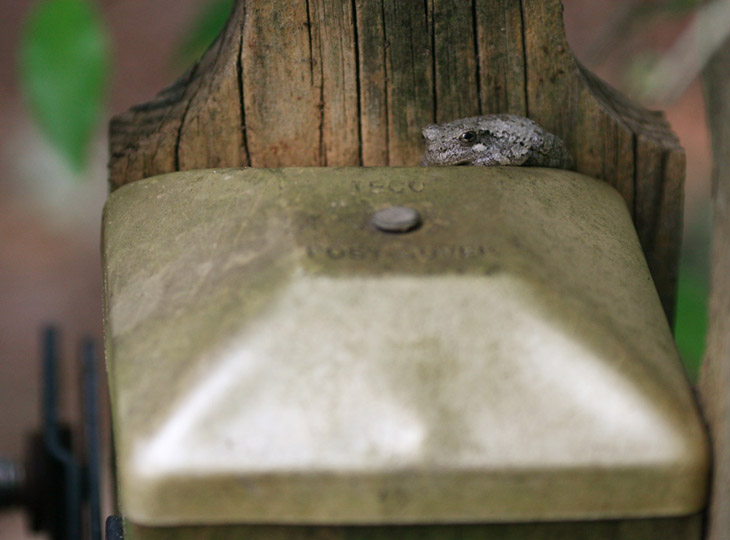


 This one was mellow enough for me to do an effective scale shot, which you can compare with the first by knowing that the fencepost it is perched upon is a 4×4 inch post, so about 9 centimeters square – roughly the size of my palm. Or I could say that while the adult was the length of my thumb, this one was the size of my thumbnail (though that’s my forefinger in the pic.) Totally adorable.
This one was mellow enough for me to do an effective scale shot, which you can compare with the first by knowing that the fencepost it is perched upon is a 4×4 inch post, so about 9 centimeters square – roughly the size of my palm. Or I could say that while the adult was the length of my thumb, this one was the size of my thumbnail (though that’s my forefinger in the pic.) Totally adorable.


 It is important to note that this is not National Asshole Day, and also that we ourselves are not exempt (even if we normally have this going on anyway.) Chances are, if anyone figures out we’re the ones with the ‘holiday spirit,’ we couldn’t escape it anyway. Embrace it reluctantly, develop those frown lines, let our irritated mumbling be heard! Let’s drag the ‘norms’ down into the mud with us and become one big dysfunctional family, if only for a day.
It is important to note that this is not National Asshole Day, and also that we ourselves are not exempt (even if we normally have this going on anyway.) Chances are, if anyone figures out we’re the ones with the ‘holiday spirit,’ we couldn’t escape it anyway. Embrace it reluctantly, develop those frown lines, let our irritated mumbling be heard! Let’s drag the ‘norms’ down into the mud with us and become one big dysfunctional family, if only for a day. The nice thing about going long periods without rain is that scheduling photo outings isn’t difficult – provided you can cope with the heat. The recent rains have changed this quite a bit, and I’ve had to switch several student appointments around due to cruddy weather. This past Saturday, we watched the weather reports on practically an hourly basis and chanced a botanical garden outing in the morning before the rains were expected to hit – as it was, it started slowly just before we were to wrap up, and came down in earnest right after the session ended. So yeah, clean living and faith in Nothing and all that jazz…
The nice thing about going long periods without rain is that scheduling photo outings isn’t difficult – provided you can cope with the heat. The recent rains have changed this quite a bit, and I’ve had to switch several student appointments around due to cruddy weather. This past Saturday, we watched the weather reports on practically an hourly basis and chanced a botanical garden outing in the morning before the rains were expected to hit – as it was, it started slowly just before we were to wrap up, and came down in earnest right after the session ended. So yeah, clean living and faith in Nothing and all that jazz…
 Many of the flowers were past their peak and showing it, so pollinator activity was limited, probably disappointing this minuscule crab spider who wasn’t doing a very good job of blending in – I’m not sure targeting the color-blind insects is the best strategy. I’ve been counting on the botanical garden to give me more opportunities for decent crab spider pics, and it’s been letting me down this year. Striking fear into the hearts of gnats is not what I’m after – show me something that can take down a
Many of the flowers were past their peak and showing it, so pollinator activity was limited, probably disappointing this minuscule crab spider who wasn’t doing a very good job of blending in – I’m not sure targeting the color-blind insects is the best strategy. I’ve been counting on the botanical garden to give me more opportunities for decent crab spider pics, and it’s been letting me down this year. Striking fear into the hearts of gnats is not what I’m after – show me something that can take down a 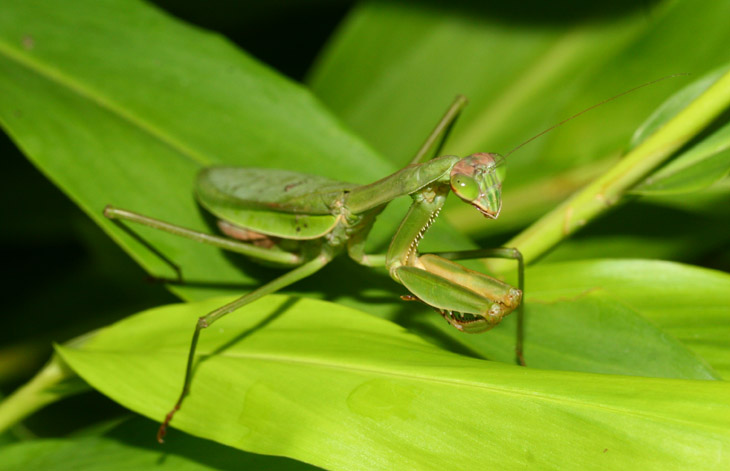
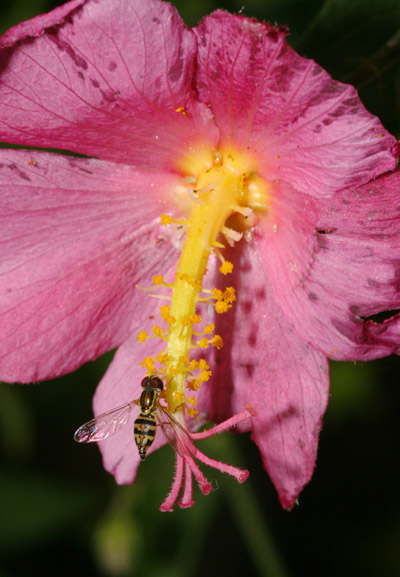 Like the anoles, you can pick your favorite hoverfly photo too, since I captured several while I was there; this is the first that will appear in the post. From the very distinctive abdominal markings I’m going to say this is a Toxomerus geminatus – if it’s not, it’s trying to look like one anyway and I won’t take the blame for that. The hoverflies were pretty much the only pollinators to be seen that morning and weren’t bothered by the fading glory of the blooms; I can’t say that I spotted one lepidopteran the entire time.
Like the anoles, you can pick your favorite hoverfly photo too, since I captured several while I was there; this is the first that will appear in the post. From the very distinctive abdominal markings I’m going to say this is a Toxomerus geminatus – if it’s not, it’s trying to look like one anyway and I won’t take the blame for that. The hoverflies were pretty much the only pollinators to be seen that morning and weren’t bothered by the fading glory of the blooms; I can’t say that I spotted one lepidopteran the entire time.
 The other hoverfly shot, a bit more personal – I’m not even going to try to identify this one. It had paused while partaking of this maybe-daisy to clean the copious pollen from its legs, but three other frames were discarded because nailing the prime focus at this magnification eluded me. If you want to pursue macro work, aim for early mornings and very still days to at least minimize how much the plants (and thus the occupants thereof) wave in and out of your focus range. Note the petals, and how blurred they are front and back – focus range is very short, and even a mild breeze can bend a flower blossom far more than that.
The other hoverfly shot, a bit more personal – I’m not even going to try to identify this one. It had paused while partaking of this maybe-daisy to clean the copious pollen from its legs, but three other frames were discarded because nailing the prime focus at this magnification eluded me. If you want to pursue macro work, aim for early mornings and very still days to at least minimize how much the plants (and thus the occupants thereof) wave in and out of your focus range. Note the petals, and how blurred they are front and back – focus range is very short, and even a mild breeze can bend a flower blossom far more than that.
 And one last one, because – once again having to be to the right of the text. I’m not going to try to identify these flowers, I just happened to like their layout and color. It might have been nice to be there on a brighter day and thus induce some brightness and color from the background as well, and not make these appear like they were photographed at night, but their own color might have had less impact then.
And one last one, because – once again having to be to the right of the text. I’m not going to try to identify these flowers, I just happened to like their layout and color. It might have been nice to be there on a brighter day and thus induce some brightness and color from the background as well, and not make these appear like they were photographed at night, but their own color might have had less impact then.
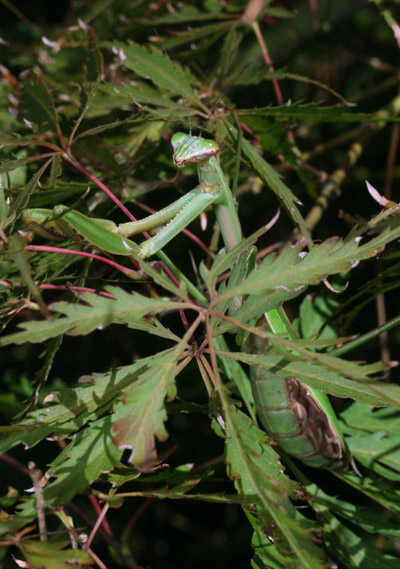 Anyway, on to the updates. I
Anyway, on to the updates. I  I’d said I thought we might have had two that had moved back to the Japanese maple, and so we did; they seem to alternate appearances, since this one showed up the same day I stopped seeing the green pregnant one. I’m never really sure whether they go for deep cover within the tree or meander off to someplace else for a while – it’s not a big tree, but it’s dense. This one, here down on the phlox plants surrounding the tree, was showing no signs of pregnancy, and I wondered if it was the same one that had
I’d said I thought we might have had two that had moved back to the Japanese maple, and so we did; they seem to alternate appearances, since this one showed up the same day I stopped seeing the green pregnant one. I’m never really sure whether they go for deep cover within the tree or meander off to someplace else for a while – it’s not a big tree, but it’s dense. This one, here down on the phlox plants surrounding the tree, was showing no signs of pregnancy, and I wondered if it was the same one that had 


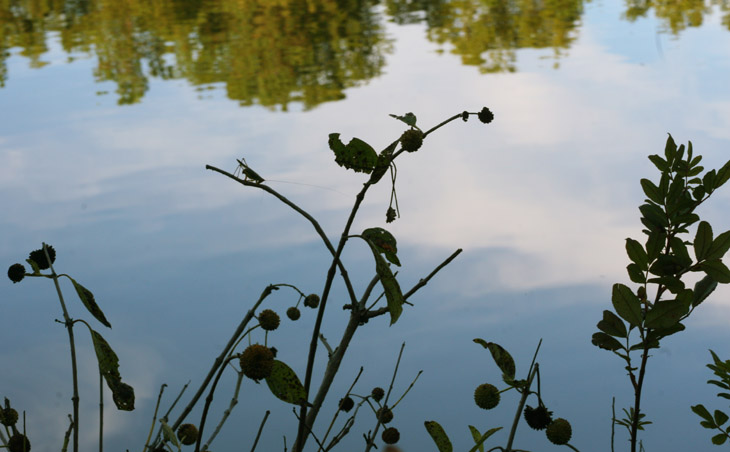
 In fact, this small section of bushes was home to several specimens of Carolina mantis (Stagmomantis carolina,) smaller than the Chinese mantis but native rather than introduced. Which of course raises the question of how we determine “introduced,” since the similarities between the two species are much greater than that between, say, a Carolina mantis and a shield bug, or really anything else. Chances are the species was also introduced to North America well in the past, before being taxonomically described in the 18th century as a “native” then. At some point I’ll look up the genetic comparison between them.
In fact, this small section of bushes was home to several specimens of Carolina mantis (Stagmomantis carolina,) smaller than the Chinese mantis but native rather than introduced. Which of course raises the question of how we determine “introduced,” since the similarities between the two species are much greater than that between, say, a Carolina mantis and a shield bug, or really anything else. Chances are the species was also introduced to North America well in the past, before being taxonomically described in the 18th century as a “native” then. At some point I’ll look up the genetic comparison between them.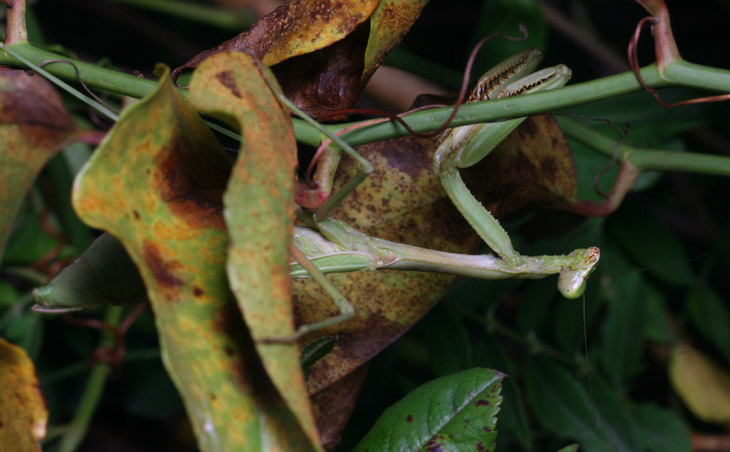
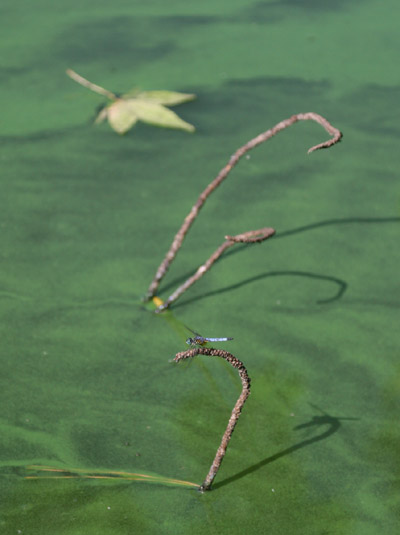 A month ago, when we’d been for a long period without rain, the water developed a notable patina of algae which would produce interesting patterns with the input of a breeze, and I took the opportunity to shoot some semi-abstracts when a blue dasher dragonfly (Pachydiplax longipennis) posed on a mostly-submerged pine branch. With two weeks of downpours introducing fresh water, the algae is mostly gone now and the pond level back where it belongs, even though many plants were hit too hard by the lack of rain to fully recover this year.
A month ago, when we’d been for a long period without rain, the water developed a notable patina of algae which would produce interesting patterns with the input of a breeze, and I took the opportunity to shoot some semi-abstracts when a blue dasher dragonfly (Pachydiplax longipennis) posed on a mostly-submerged pine branch. With two weeks of downpours introducing fresh water, the algae is mostly gone now and the pond level back where it belongs, even though many plants were hit too hard by the lack of rain to fully recover this year.